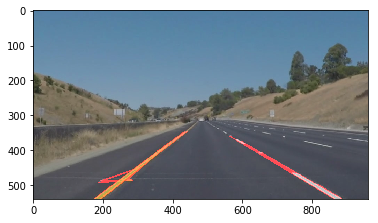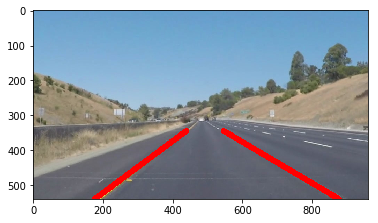There were several transformations that had to be done on the original image to eventually find lane lines. OpenCV was used within Python, as OpenCV contains many high level and powerful image analysis functions. The steps to move from an image to drawing lane lines are as follows:
gray = grayscale(image)
blur_gray=gaussian_blur(gray,kernel_size)
Detect edges in the image. Edges are found by finding the derivative in x and y using the canny() function
edges = canny(blur_gray, low_threshold, high_threshold)
Lane lines should only be found in the triangular region in front of the car. To get rid of some noise, I chose to crop the region of interest to be adjusted with some offset.
x_offset=50
y_offset=75
vertices = np.array([[(0,imshape[0]),(imshape[1]/2-x_offset, imshape[0]/2+y_offset), (imshape[1]/2+x_offset, imshape[0]/2+y_offset), (imshape[1],imshape[0])]], dtype=np.int32)
image_masked=region_of_interest(edges,vertices)
image_lines = hough_lines(image_masked, rho, theta, threshold, min_line_len, max_line_gap)
At this point, lines are found in the region of interest. To find lane lines, draw_lines2() was created in an ad-hoc manner to find left lane lines and right lane lines.
An overview of finding lane lines on a single image is briefly described below:
for line in lines:
for x1,y1,x2,y2 in line:
m = (y2-y1)/(x2-x1)
b = y1-m*x1
if m < -0.5 and m > -1: #left lane
m_lefts.append(m)
b_lefts.append(b)
if m > 0.5 and m < 1: #Right Lane
m_rights.append(m)
b_rights.append(b)
m_right = np.mean(m_rights)
b_right = np.mean(b_rights)
m_left = np.mean(m_lefts)
b_left = np.mean(b_lefts)
c. fit a line to slope and y-intercept. The lane lines should always be starting from the bottom of the image (top of the image as a matrix) and should extent to the midpoint minus some offset.
right_line_x1 = int((image.shape[0]-b_right)/m_right)
right_line_y1 = image.shape[0]
right_line_x2 = int((image.shape[0]/2+y_offset-b_right)/m_right)
right_line_y2 = int(image.shape[0]/2+y_offset)
left_line_x1 = int((image.shape[0]-b_left)/m_left)
left_line_y1 = image.shape[0]
left_line_x2 = int((image.shape[0]/2+y_offset-b_left)/m_left)
left_line_y2 = int(image.shape[0]/2+y_offset)
One shortcoming is the small sample size of videos to process. Videos from different freeways, different time of days, and weather are all more data to process and tune the lane finding algorithm. Another shortcoming is the hardcoded parameters in the lane finding algorithm. For example, each transformation, edge, grayscale, Hough, has it's own fixed parameters.
An improvement to add use the average, from all the frames, of the mean and y-intercept of each frame. Given the camera being in a fixed location, the lane lines look like they will be in generally the same x,y locations and contain the same slope. This would decrease the noise and jitter in each frame. Another improvement is to fit a spline or high order polynomial curve to the lanes. Lastly, dynamic updating of algorithm parameters can lead to a more precise and more robust overall pipeline.




